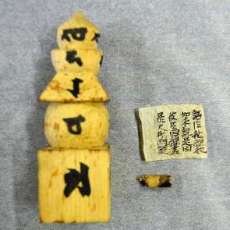I have a standard piece of advice that I give to both patients and meditation students when they are suffering from the sad state of society, the apparently crazy people living in it, and the awful things that they do. “If this beautiful world sometimes appears like a giant garbage dump,” I say, “you have only two choices. You can add more garbage to the pile or place a little gem on top of it.” This is a good aspiration but may be easier said then done.
Further, it hits very close to home when, not infrequently, I see expressions of hatred, malignant intentions, disdain ,or outright slander coming from Buddhists, Mahayana-ists, long-time students of Vajrayana, on my Facebook feed. It begs the question: if the goal is to make a better world, to help others toward a happier existence, to get rid of the horrors that seem to multiply before our eyes, or to achieve our own transformation, is hatred an effective response? Might there be a more powerful way, not just to live with these manifestations, but to actually make a change?
We are not speaking about social action, because here too a motivation of rage and self-righteous indignation is likely to deflect from any positive outcome. First, we need to dig a little deeper into the environment that fosters this behavior and into human nature itself, rather than merely offering clichés or platitudes as a solution.

Outer morality
Let’s start with the dystopian world that seems to envelop us at the moment. Friedrich Nietzsche’s On the Genealogy of Morals is a classic textbook of moral relativism—a philosophy that is the overarching underpinning of today’s society. Moral relativism (or ethical relativism) is the position that moral or ethical attitudes are not based on universal truths, but instead are the result of social, cultural, historical, or personal circumstances. This is part and parcel of the vacuity of materialist reductionism, a life approach that moves us ever closer toward a truly sociopathic society. By this theory, a culture based on hatred, jealousy, or violence is just another endless possibility in the evolution of mores and morals.
This goes along with the strange ideology that compassion was an evolutionary development that happened simply as a matter of survival and strength in numbers. This again is the concept that we are basically civilized psychopaths. We find this echoed in the lasting influence of Freudian psychology, with the instinctive id swarming below the egoic surface, just waiting to burst its malignant head through the glass ceiling of civilized behavior. This then resonated with Freud’s nephew, who is the veritable creator of the modern advertising and political industries of influence and control of the masses, as they exist today, Edward Bernays.
Inner morality
Clearly these notions about human nature are not based on self-awareness, inner attention, or an unsullied perception of others. And they fly in the face of the Mahayana philosophy and the internal experience of spiritual adepts and regular meditators throughout the ages. The practices of meditation and mindfulness make it possible to confirm with certainty that Chogyam Trungpa’s assertion of “basic goodness” has a basis in fact. How odd indeed is the concept that all the compassionate teachings of Christianity, Buddhism, and other mainstream religions were just a cultural concept of the superstitious and self-deluded, rather than a direct experience of our fundamental being.
This moral confusion, the Western origins of which extend back to ancient Greece, errs because it simply does not understand the difference between the two parts of our human structure: persona and essence, let alone our higher nature. Persona is the social mask given by culture, by the norms of family, education, and society, wherever and whenever we live. Essence is how we were born—biology, body, karma, predilections, strengths, and weaknesses. One is a fabrication, and one is what we actually have to work with.
One can evolve. The first can only upgrade, since it is nothing but a sophisticated collection of actions, beliefs, habits—programming. The second can mature, ripen into a fully actualized human being. For persona, any belief is possible. For essence, true conscience and awakeness become available. Unfortunately, the majority of people, notably philosophers, psychologists, and the world’s leading experts and influencers, come to live in the fabrication of person, not in the actuality of their essential self.
On the other hand, the Theory of Moral Sentiments, written by the Scottish economist and philosopher Adam Smith, is a profound exploration of the nature of morality and human relationships. Published in 1759, it offered a sane explanation of empathy, and how we have an impartial observer who, without prejudice or bias, looks to alleviate the suffering that is present. What he was talking about is not different from entering one’s essence, one’s original nature without all our personal baggage or inherited beliefs. And so, in the end, there is clearly an inner morality and outer morality. Understanding this duality resolves the thousands of years of intellectual back and forth between moral relativists and moral realists.
Old and new stabs at solving this dilemma of conflict and animosity are exemplified in best-selling author and neurologist Jonathan Sacks’s Morality, Restoring the Common Good in Divided Times. Here the extended analysis of our problem focuses solely on how society and culture have deteriorated, creating a climate of egocentricity, dissent, and lack of mutual respect. This wholly misses the fundamental causes which are, always and in every case, the human psyche. It is an external approach to an internal problem. And because of this, no workable solution is even hinted at, other than platitudes about how we should treat each other better and get along.
In this, practicing Buddhists (and other serious spiritual seekers) have a tremendous leg up. They have at hand the methods of self-awareness, self-examination, of learning how to let go of ego-fixations and live ever more in their essential self. That self is the seed of maturation onto ever greater transformation into fulfilling our human and supra-human potential.

Real solutions for real people
Our whole problem boils down to the fact that in previous eras humanity was controlled and contained by outer forces. Fear, absolute rule, feudal societies, caste systems, religious dogma, and highly repressive social orders have been the norm. Everything was held together by external retributions and punishments that kept individual more or less in line. In short, humanity did not have to grow up. And so they stayed largely in a state of arrested development, serving whatever masters demanded of their time and life.
Today, while we might think we are wage slaves or under all kinds of restraints, we are, in comparison, incredibly free, physically and emotionally. A trip to any number of developing countries or totalitarian regimens easily demonstrates how poverty, inequity, corruption, and rigid power structures keep humans both externally in chains and psychologically infantilized.
Now, for the first time in human history, large swathes of humanity are called on to mature, grow up, take responsibility—by working on themselves. This requires, in every single case, a two-pronged approach: work on our psychology and work on our spirituality.
Psychology means understanding the workings of our mind and that of others, and an honest examination of our motivations, traumas, strengths, and weaknesses, even moment to moment. True enough, that is difficult with the current framework of modern psychology, which is simply primitive in many regards. But new paradigms are arising, and an accurate map of the human psyche is in the offing.
“Spiritually” means mind-training that lays bare our underlying strata of being, our presence, and raw awareness, which fosters clear seeing, inner peace, certainty, strength, and wisdom. This is done through “meditations,” which may entail breath, visualization, sound and mantra, movement, and more, done right.
A perfect tool
One particularly relevant example is the well known (but clearly not practiced enough) method of Tonglen or “sending and receiving.” Both a psychological and spiritual exercise, Tonglen fosters deep empathy and compassion while cutting at the roots of self-inflation and narcissistic ideation.
A foundation of Mahayana praxis, some excellent books outline the methods in detail, such as Ken McLeod’s Wake Up to Your Life. Indeed, Ken told me that this one technique was the most useful and powerful thing he had learned in his long stretch doing a double (almost seven years) three-year, three-month traditional Tibetan Buddhist retreat.
One great advantage of the method is that we can take our own feelings and inner states as the object of the practice, or any person outside oneself. Seeing the arrogance, stupidity, selfishness, hatred, fearfulness, or any negative emotion or physical ailment or pain of another, we breathe in as a dark smoky substance. That’s right, we take it on. It is purified within the crystal luminosity of our own being, and we breath out, and indeed radiate light to that person all the qualities of kindness, unselfish caring, courage, and sanity to counter those that we feel are embedded in them.
Or, we can start with our own hatred, fear, depression, or pain, and inhale the similar suffering of all other people, all sentient beings going through this same negative experience. And to them (and ourselves) we radiate a multicolored light of freedom from pain, a sense of equanimity, happiness, fulfillment, love, and so on. In all cases we now see this individual or this multitude, undergo a change. They are smiling, filled with joy and goodness, compassion and strength, with the power and wisdom to uplift themselves and others. A simple and terrifying meditation!
The strange thing is, this visualization has a “Teflon effect.” Instead of actually taking on the pain or confused emotionality of others, you yourself are relieved. I can’t tell you how many times I have seen this work, even in the case of one’s own toothache or stomach pain, by taking on the toothache or cramping of all beings. This is because when one truly lets go of self-centeredness, there is nowhere for the pain, suffering, hatred, fear, or depression to land.
Such a method is not just “mental” but changes our entire bioenergetic matrix. It alters the kinds of rarefied substances that flow through our body and informs our consciousness itself. And this kind of inner change does affect others. Hatred is an energy, a real substance that flows toward others and can only harm, since it only intends to hurt.
Compassion and a desire to help or heal others is also a substance that flows forth and changes the object of its focus. No matter how slight, there is still an effect. If we want to change the world, or the people that trigger our own anger, hatred, disgust or outrage, we can just throw genuine love their way.
It is not necessarily easy, in the way that succumbing to self-satisfied anger and self-validation is easy. In my own case, when I fail to make this effort, it is both lazy and irresponsible, because I know better. And I know that, at our core, we are all better than that.
See more
Related features from BDG
The Missing Sense in Vajrayana Practice
Psychological Development and the Five Elements
The Conflict of Tradition Versus Innovation
Confronting the Five Horsemen of the Current Apocalypse















I really appreciate how you’ve connected modern life with ancient wisdom in this post. Buddha’s teachings offer so much guidance for cultivating inner peace and mindfulness. I’ve been curating some of his quotes that reflect on these topics and how we can apply them today. You might find it insightful:The Buddha Quotes. Looking forward to reading more from you!